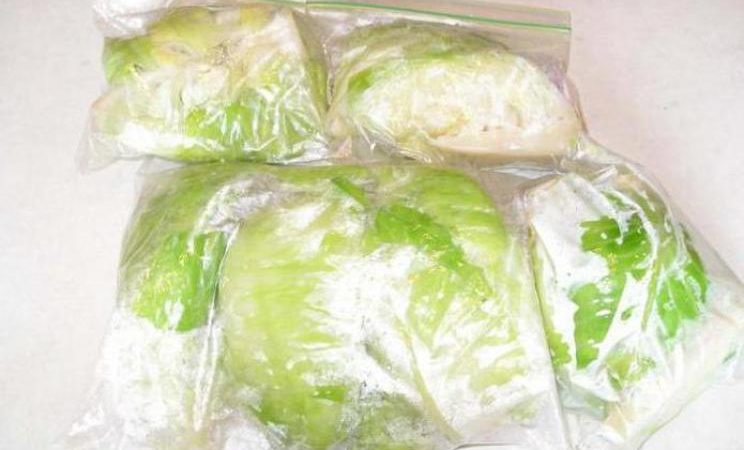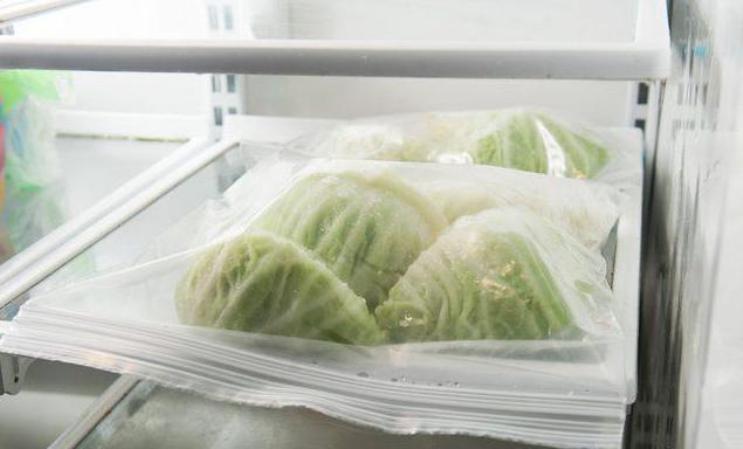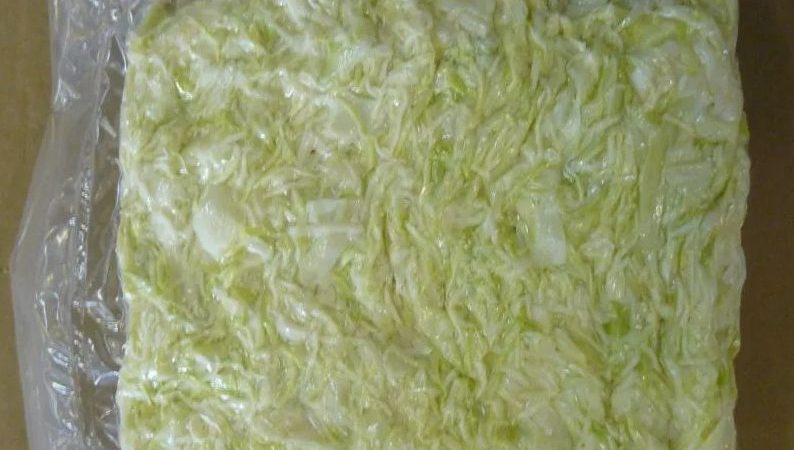The best ways to freeze white cabbage for the winter at home
A rich harvest of white cabbage harvested on the site is a valuable supply of vitamins for the winter. Freezing at a certain temperature and humidity will allow you to keep the vegetable until next season and use it for preparing first courses, casseroles, cabbage rolls and pastries.
The content of the article
Is it possible to freeze white cabbage
Many varieties of white cabbage do not tolerate the cold well, with late harvesting from the garden it becomes soft, lethargic and loses its crunch. But many varieties are suitable for freezing and long-term storage. Such a stock will be useful for many cases - making pies with filling, borscht, stews and other dishes.

How properties, taste, composition change
After defrosting, cabbage retains almost all its beneficial properties. Nevertheless, long-term storage to some extent affects the composition of the product: harmful enzymes appear in it. Therefore, before harvesting, the heads of cabbage are poured over with boiling water or kept over steam for 1-2 minutes. This blanching prevents the formation of hazardous substances.
Advantages and disadvantages
Frozen cabbage stored until summer - this is a definite plus for housewives:
- the right ingredient is always at hand;
- cabbage is quickly defrosted, it is added to hot dishes immediately from the freezer;
- does not lose useful properties and does not change the vitamin composition.
The disadvantages of a semi-finished product include the lack of elasticity and crunch. For example, such a product is hardly suitable for fresh salads. The appearance of the vegetable also becomes less appetizing and attractive. In addition, a large freezer is required for the workpiece.
Reference. Many housewives freeze cabbage along with chopped carrots, green onions or bell peppers.
Choosing and preparing cabbage
For long-term storage at subzero temperatures, not only white cabbage is suitable, but also kohlrabi, cauliflower and even broccoli. They choose only high-quality specimens without signs of decay that meet the following requirements:
- free of black spots and traces of mold;
- immature and collected on time;
- the structure of the vegetable is dense, correctly formed.
Heads of cabbage are carefully examined for slugs, caterpillars, or other insects. When defrosting, they inevitably end up in the dishes, thereby reducing all the efforts of the hostess to zero. Therefore, before freezing, the upper leaves are removed, the vegetable is rinsed with cold water, then poured over with boiling water and wiped off with a towel.
The best varieties for freezing
Early and mid-season varieties are not suitable for freezing. They turn into a soft mass and spoil the taste of the dish.
Experienced farmers recommend freezing late varieties:
- Glory 1305
- Symphony;
- Present.
- Mara;
- Amager 611;
- Drinking;
- Filibuster;
- Gloria;
- Baby.
These varieties are practically not susceptible to cracking, diseases, and are resistant to pest damage. Therefore, they are ideal for freezing, as well as fermentation and storage fresh in the cold.
Suitable container
It is most convenient to lay out the prepared cabbage parts in disposable plastic bags. In addition, there are special packages on sale with practical reusable locks.The use of plastic containers and cling film is allowed.
Freezing methods
Freezing methods are selected depending on the purpose.
Wholly

For whole heads of cabbage, use bags or film. In winter, such specimens are suitable for making cabbage rolls. Thawed leaves do not need to be softened in hot water, as they already lose their elasticity. Carefully remove the stalk from the head of cabbage, remove the damaged upper leaves, wash in cool water. A well-dried vegetable is tightly wrapped with cling film, put into the freezer.
Leaves

Frozen cabbage leaves are used for cabbage rolls, casseroles, as well as for medical compresses.
Preparation takes a few minutes:
- the head of cabbage is cleaned of the upper damaged and hard leaves, washed;
- inspect for caterpillars and slugs;
- the sheets are separated to the stump, put into boiling water for 2-3 minutes;
- laid out in bags and placed in the freezer.
Chopped

In this form, many housewives prefer to freeze the vegetable. It is convenient and practical, the container takes up less space than whole forks. Cabbage is added to borscht or used for stewing.
Training:
- peel and rinse the heads of cabbage;
- blot with a paper towel;
- chop into pieces of the desired size;
- packaged in a prepared container and send to the freezer.
Carrots or peppers are added to shredded cabbage, and sometimes semi-finished mushrooms.
In what form to freeze
Fresh cabbage is a source of vitamins and nutrients, but there are no less of them in sauerkraut and stew. With a large amount of cooked dish, it is also put into the freezer.
Fresh
Fresh cabbage is stored at subzero temperatures for the subsequent preparation of first courses, side dishes, casseroles. Other fresh vegetables are added to the vegetable mixture - carrots, beets, bell peppers, as well as herbs. For defrosting, simply place the bag on the refrigerator shelf or on the kitchen table.
Pickled
Lovers of cabbage soup or aromatic sauerkraut store cabbage in this form. The product is fermented in any way until ready. Glass jars are not suitable for freezing it, since they burst at sub-zero temperatures.
A convenient way is with plastic containers or non-leaking plastic bags. Sauerkraut will not lose its beneficial properties after freezing, however, a cellar or a warmed one is more suitable for storing it balconywhere it does not deteriorate for a long time.
Stew
Use plastic containers to freeze the stew. The finished product is allowed to cool to room temperature, the resulting juice is drained. Packaged in boxes or bags with locks.
Reference. When stewing cabbage, add a minimum of vegetable oil. This will not only help reduce calories but also reduce fluid formation. This ingredient is added after defrosting the cabbage in a frying pan.
Storage periods

They consume frozen cabbage before summer, and with the appearance of the first harvest of young vegetables, they get rid of semi-finished products. The optimum storage temperature is from -15 to -18 ° C. Do not re-freeze or store defrosted cabbage in the refrigerator.
How to defrost properly
In borscht, hodgepodge or other hot dish, semi-finished products are added directly from the freezer. Do not use a microwave oven or hot water to speed up thawing.
Where to apply
Cabbage harvested for the winter makes it easier for housewives to cook borscht, cabbage soup, as well as casseroles, vegetable stews and everyone's favorite stuffed cabbage (including lazy ones). Shredded heads of cabbage are a ready-made option for filling in pies, dumplings and pies.
It is interesting:
Proven ways to store Savoy cabbage for the winter at home.
Proven ways to store Brussels sprouts fresh, frozen and canned for the winter.
In what form and how to properly freeze Brussels sprouts for the winter in the freezer.
Conclusion
It is recommended to freeze white cabbage for the winter in several ways - with heads of cabbage, leaves, or in chopped form. Each housewife chooses the appropriate method, taking into account the capabilities of her own freezer. The vegetable retains its beneficial properties and vitamins, it is suitable for preparing first and second courses.